Woolworth Building
| Woolworth Building | |
|---|---|
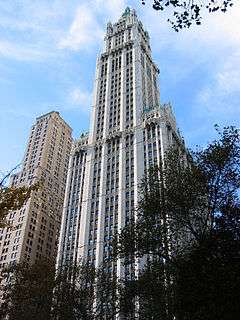 Woolworth Building in November 2005 | |
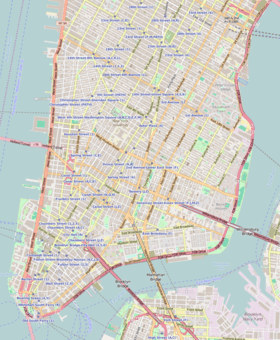 Location within Lower Manhattan 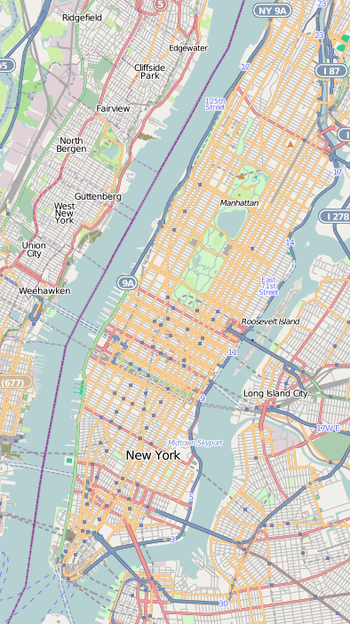 Woolworth Building (Manhattan)  Woolworth Building (New York City)  Woolworth Building (New York)  Woolworth Building (the US) | |
| Record height | |
| Tallest in the world from 1913 to 1930[I] | |
| Preceded by | Metropolitan Life Insurance Company Tower |
| Surpassed by | 40 Wall Street |
| General information | |
| Location |
233 Broadway Manhattan, New York City |
| Construction started | 1910 |
| Completed | July 1, 1912[1] |
| Opening | April 24, 1913 |
| Renovated | 1977–1981 |
| Cost | US$13.5 million (equivalent to US$342,341,379 in 2018) |
| Owner | KC Holdings, Inc. |
| Height | |
| Roof | 792 feet |
| Technical details | |
| Floor count | 57 |
| Lifts/elevators | 34 |
| Design and construction | |
| Architect | Cass Gilbert |
| Structural engineer | Gunvald Aus and Kort Berle |
| Renovating team | |
| Renovating firm | Ehrenkrantz Group |
|
Woolworth Building | |
   | |
| Coordinates | 40°42′44″N 74°00′29″W / 40.71222°N 74.00806°WCoordinates: 40°42′44″N 74°00′29″W / 40.71222°N 74.00806°W |
| Area | 0.5 acres (0.2 ha) |
| NRHP reference # | 66000554 |
| Significant dates | |
| Added to NRHP | November 13, 1966 |
| Designated NHL | November 13, 1966 |
| Designated NYCL | April 12, 1983 |
| References | |
| [2][3][4][5] | |
The Woolworth Building, at 233 Broadway, Manhattan, New York City, designed by architect Cass Gilbert and constructed between 1910 and 1912, is an early US skyscraper. The original site for the building was purchased by F. W. Woolworth and his real estate agent Edward J. Hogan by April 15, 1910, from the Trenor Luther Park Estate and other owners for $1.65 million. By January 18, 1911, Woolworth and Hogan had acquired the final site for the project, totaling $4.5 million. More than a century after its construction, it remains, at 792 feet (241 m), one of the 100 tallest buildings in the United States as well as one of the 30 tallest buildings in New York City. It has been a National Historic Landmark since 1966,[6][7][8] and a New York City landmark since 1983.[9]
Architecture
The Woolworth Building was designed in the neo-Gothic style by the architect Cass Gilbert, whom Frank Woolworth commissioned in 1910 to design a 20-story office building [9] as the F. W. Woolworth Company's new corporate headquarters on Broadway, between Park Place and Barclay Street in Lower Manhattan, opposite City Hall. Originally designed to be 420 feet (130 m) high, the building was eventually elevated to 792 feet (241 m). At its opening, the Woolworth Building was 60 stories tall and had over 5,000 windows.[10] The construction cost was US$13.5 million. With Irving National Exchange Bank Woolworth set up the Broadway-Park Place Company to finance the building, but by May 1914, had purchased all of the shares from the bank, thus owning the building outright. On completion, the Woolworth building topped the record set by the Metropolitan Life Insurance Company Tower as the world's tallest building.

Construction was completed in 1912 and the building opened on April 24, 1913. President Woodrow Wilson turned the lights on by way of a button in Washington, D.C. that evening.[10]
Given its resemblance to European Gothic cathedrals, the structure was called "The Cathedral of Commerce" by the Reverend S. Parkes Cadman in a booklet of the same title published in 1916.[10][11][12] It remained the tallest building in the world until the construction of 40 Wall Street and the Chrysler Building, also in New York City, in 1930; an observation deck on the 57th floor attracted visitors until 1941.
The building's tower, flush with the main frontage on Broadway, joins an office block base with a narrow interior court for light. The exterior decoration was cast in limestone-colored, glazed architectural terra-cotta panels.[10] Strongly articulated piers, carried—without interrupting cornices—right to the pyramidal cap, give the building its upward thrust. The Gothic detailing concentrated at the highly visible crown is over scaled, able to be read from the street level several hundred feet below.
Engineers Gunvald Aus and Kort Berle designed the steel frame, supported on massive caissons that penetrate to the bedrock. The high-speed elevators were innovative, and the building's high office-to-elevator ratio made the structure profitable.
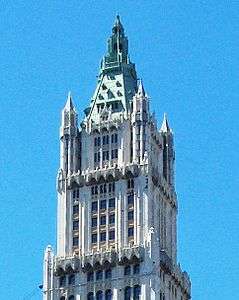
The ornate, cruciform lobby, is "one of the most spectacular of the early 20th century in New York City".[9] It is covered in Skyros veined marble,[11] has a vaulted ceiling, mosaics, a stained-glass ceiling light and bronze fittings. Over the balconies of the mezzanine are the murals Labor and Commerce. Corbel sculptures include Gilbert with a model of the building, Aus taking a girder's measurements, and Woolworth counting nickels.[9][11] Woolworth's private office, revetted in marble in the French Empire style, has been preserved.
The building's façade was restored between 1977 and 1981 by the Ehrenkrantz Group,[11] during which much of the terra-cotta was replaced with concrete and Gothic ornament was removed.[9]
History
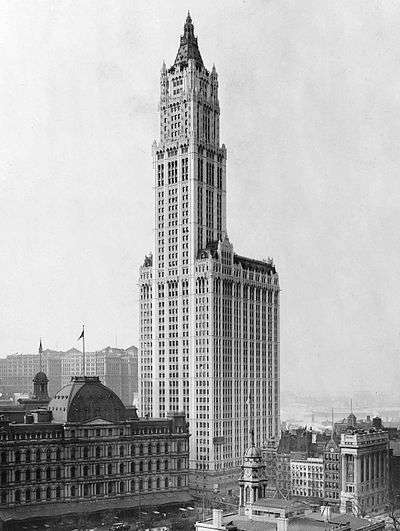
The building was owned by the Woolworth company for 85 years until 1998, when the Venator Group (formerly the F. W. Woolworth Company) sold it to the Witkoff Group for $155 million.[13] Until recently, that company kept a presence in the building through a Foot Locker store (Foot Locker is the successor to the Woolworth Company).
Prior to the September 11 attacks, the World Trade Center was often photographed in such a way that the Woolworth Building could be seen between 1 and 2 World Trade Center.[14] After the attacks, which occurred only a few blocks away, the building was without electricity, water and telephone service for a few weeks and had broken windows and the top turret was damaged by falling rubble. Increased post-attack security restricted access to most of the ornate lobby, previously a tourist attraction,[15] although the lobby reopened to public tours in 2014.[16]
The structure has a long association with higher education, housing a number of Fordham University schools in the early 20th century. Today, the building houses, among other tenants, TTA Inc., Control Group Inc., AIGA, and the New York University School of Professional Studies' Center for Global Affairs.[17]
In August 2012, The New York Times reported that an investment group led by Alchemy Properties, a New York developer, bought the top 30 floors of the landmark on July 31 for $68 million from the Witkoff Group and Cammeby's International.[18] The firm plans to renovate the space into luxury apartments and convert the penthouse into a five-level living space.[19] The lower 28 floors are still owned by the Witkoff Group and Cammeby International, who plan to lease them as office space.
The project will cost approximately $150 million, according to the article, including its $68 million purchase price. In August 2014, the New York Attorney General's office approved Alchemy's offering plan for condos at the newly branded Woolworth Tower Residences.[20] The $110 million price tag for the building's penthouse unit is the highest asking price ever for an apartment in downtown Manhattan.[21]
Tenants
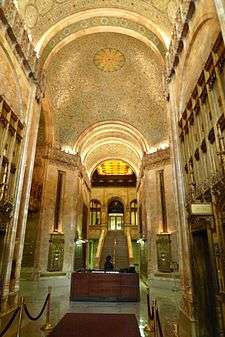
At the building's completion, the F. W. Woolworth Company occupied only one and a half floors of the building,[9] but, as the owner, profited from renting space out to others, including the Irving National Exchange Bank and Columbia Records. Columbia Records moved into the building in 1913 and housed a recording studio in it.[22] In 1917, Columbia made what are considered the first jazz recordings, by the Original Dixieland Jass Band, in this studio.[23][24]
During World War II, the Kellex Corporation, part of the Manhattan Project to develop nuclear weapons, was based here.[25]
In popular culture
Architecture
- The Lincoln American Tower in Memphis, Tennessee, built in 1924, is a small replica of the building, standing at one-third its height.[26]
Film
- In Applause (1929), April (Joan Peers) and her sailor boyfriend Tony (Henry Wadsworth), are sightseeing atop a tall building. April: "Look, there's the Woolworth building". Tony: "That's some sight isn't it", April: "It's wonderful". Tony: "You're wonderful".
- The film Five and Ten (1931) is loosely based on Woolworth heiress Barbara Hutton and has many references to "the tower" that is being built. The main characters, played by Marion Davies and Leslie Howard, get stranded overnight atop the skyscraper.
- In Winner Take All (1932), Jimmy (James Cagney) sends Peggy (Marian Nixon) a post card with the picture of the Woolworth Building.
- In On the Town (1949), one of the sailors on leave in Manhattan (Frank Sinatra) uses an out-of-date guidebook which states that the Woolworth Tower's is the tallest building in the world.
- In Singin' in the Rain (1952), set in 1927, Don Lockwood (Gene Kelly) laments the colossal failure of his latest film, "The Dueling Cavalier" saying after its release, nobody would come to see him jump off the Woolworth Building into a damp rag.
- In Spider-Man 2 (2004), Peter Parker (Tobey Maguire) delivers a number of pizzas to a receptionist (Emily Deschanel) at the building.
- In the Disney film Enchanted (2007), the building is the site of the film's grand climax.
- In the opening scenes of Cloverfield (2008), the building is seen collapsing after Clover critically damages it, causing a dust cloud to flood through nearby streets.
- In Baz Luhrmann's film adaptation of The Great Gatsby (2013), Nick Carraway works in the building as a stock broker for Chase. An early scene shows a spectacular tilt down from the top of the building.
- In the movie Fantastic Beasts And Where To Find Them (2016), the Magical Congress of the United States of America is concealed from No-Maj view inside the building itself.[27]
Video games
- The "Woodworld Building" in the video game Grand Theft Auto IV (2008) mimics the Woolworth Building in its name, architectural style, and street address number. The building also appears in Grand Theft Auto: Chinatown Wars, but only its bottom floors are rendered due to the game's top-down angle.
Literature
- In the novel Peak (2007), the protagonist is arrested for climbing the building.
- In Langston Hughes' poem "Negro" the narrator has made mortar for the building.
Television
- The building is shown as the headquarters of Meade Publications in the 2006 television series Ugly Betty.[28]
- Exterior shots of the building were used to establish the headquarters of fictional cable television channel "The Explorer's Channel" which employed Paul Buchman in season four of the 1990s sitcom Mad About You.
Music
- The sheet for the song Woolworth Rag by Henri Klickmann shows an artwork of the Woolworth Building in the cover.
See also


- List of tallest buildings in the world
References
Notes
- ↑ "The Woolworth Building: The Cathedral of Commerce", April 22, 2013, New York Public Library. Retrieved June 6, 2018.
- ↑ "Woolworth Building". CTBUH Skyscraper Database.
- ↑ Woolworth Building at Emporis
- ↑ "Woolworth Building". SkyscraperPage.
- ↑ Woolworth Building at Structurae
- ↑ "Woolworth Building". National Historic Landmark summary listing. National Park Service. September 23, 2007. Archived from the original on June 6, 2011. Retrieved August 31, 2011.
- ↑ Patricia Heintzelman and Cecil McKithan (January 6, 1978). "The Woolworth Building" (PDF). National Register of Historic Places Inventory-Nomination. National Park Service.
- ↑ "The Woolworth Building--Accompanying 3 photos, exterior, from 1975". National Register of Historic Places Inventory-Nomination. National Park Service. January 6, 1978. Retrieved August 31, 2011.
- 1 2 3 4 5 6 New York City Landmarks Preservation Commission; Dolkart, Andrew S.; Postal, Matthew A. (2009), Postal, Matthew A., ed., Guide to New York City Landmarks (4th ed.), New York: John Wiley & Sons, ISBN 978-0-470-28963-1 , p. 25.
- 1 2 3 4 "Study for Woolworth Building, New York". World Digital Library. 1910-12-10. Retrieved 2013-07-25.
- 1 2 3 4 White, Norval & Willensky, Elliot (2000), AIA Guide to New York City (4th ed.), New York: Three Rivers Press, ISBN 978-0-8129-3107-5 , p. 67.
- ↑ Sutton, Philip. "The Woolworth Building: The Cathedral of Commerce". Blogs. New York Public Library. Retrieved 25 July 2013.
- ↑ "Sale no nickel, dime deal". Times Herald-Record. Middletown New York. Associated Press. June 23, 1998. Archived from the original on June 1, 2005.
- ↑ "Woolworth Building Turns 100". The Wall Street Journal. 23 April 2013. ISSN 0099-9660. Retrieved 2016-02-07.
Picture 11 of 19: The World Trade Center, shown under construction in 1970, and other modern skyscrapers eventually dwarfed the Woolworth Building, visible here at the center between the Trade Center's two towers.
- ↑ Fendrich, Laurie (January 8, 2008). "American Architectural Wonder: Keep Out". The Chronicle of Higher Education. Retrieved August 30, 2011.
- ↑ Dunlap, David W. (December 31, 2014). "Woolworth Building's Grand Arcade Is Once Again a Sight All Can See". The New York Times. Retrieved July 28, 2016.
- ↑ "NYU Center for Global Affairs to Open in Woolworth Building; Lower Manhattan Location To House Academic Programs and Host Public Events" (Press release). New York University. July 26, 2004. Retrieved 2018-06-10 – via Business Wire.
- ↑ Higgins, Michelle (August 7, 2012). "Luxury Living in Old Temple of the 5 and Dime". The New York Times. Retrieved August 24, 2014.
- ↑ Polsky, Sara (August 7, 2012). "Woolworth Building's Top Floors Will Become Luxury Condos". Curbed. Retrieved August 24, 2014.
- ↑ Samtani, Hiten (August 21, 2012). "Revealed: Floor plans for $110M Woolworth penthouse: PHOTOS". The Real Deal. Retrieved August 24, 2014.
- ↑ Perlberg, Heather (June 2, 2014). "NYC Woolworth Tower Condo Priced at Record $110 Million". Bloomberg News. Retrieved August 24, 2014. (Subscription required (help)).
- ↑ Hoffman, Frank, Encyclopedia of Recorded Sound, New York & London : Routledge, 1993 & 2005, Volume 1. Cf. p. 212, article on "Columbia (Label)".
- ↑ Cogan, Jim; Clark, William, Temples of sound : inside the great recording studios, San Francisco: Chronicle Books, 2003. ISBN 0-8118-3394-1. Cf. chapter on Columbia Studios.
- ↑ "The Woolworth Building", NYC Architecture
- ↑ "Corporate Partners". Atomic Heritage Foundation. Retrieved 31 January 2018.
- ↑ Ashby, Andy (2008-05-16). "Lincoln American lands first tenants". Memphis Business Journal. Retrieved 2008-09-22.
- ↑ Hibberd, James (November 6, 2015). "'Fantastic Beasts': 5 secrets in our photo you might have missed". Entertainment Weekly. Retrieved 2018-06-10.
- ↑ Soll, Lindsay (October 17, 2008). "The Deep Dive: Made in NYC". Entertainment Weekly. Retrieved January 21, 2010.
Bibliography
- Fenske, Gail. The Skyscraper and the City: The Woolworth Building and the Making of Modern New York. Chicago: University of Chicago Press, 2008. ISBN 978-0-226-24141-8.
- Heintzleman, Patricia; Cecil McKithan (January 23, 1978). "National Register of Historic Places Inventory/Nomination: The Woolworth Building". New York State Office of Parks, Recreation and Historic Preservation. Retrieved December 25, 2010.
- "Big Town Big Picture: The Woolworth Building". Daily News. March 11, 2009. p. 23.
External links
| Wikimedia Commons has media related to Woolworth Building. |
- Official lobby tours website
- The Woolworth Tower Residences official website
- "Designation List 164: The Woolworth Building", New York City Landmarks Preservation Commission, April 12, 1983
- "Pride and Humility in the Woolworth Building and in Ourselves" by John Stern, from beautyofnyc.org
- The Woolworth Building from GreatBuildings.com
- A Rare Glimpse Inside as the Woolworth Building Turns 100 at NY Curbed
- Medieval New York website from Fordham University, with construction details and photo images of the Woolworth Building
- Margaret Herman, Gilbert's Woolworth Building, Smarthistory
- "Cass Gilbert's Woolworth Building," by Ellen Dement on Scalar
| Records | ||
|---|---|---|
| Preceded by Metropolitan Life Insurance Company Tower |
Tallest building in the world 1913–1930 |
Succeeded by 40 Wall Street |
| Tallest building in the United States 1913–1930 | ||
.png)

